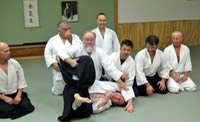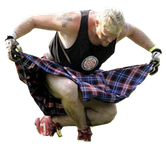From the USAF | New Student Guide | version 1.0 | 6.10
You have probably already noticed that a great deal of ceremonial bowing takes place in the dojo. It is important to understand that this activity has no religious significance in the context of your training. In Japanese culture, it is roughly the equivalent of shaking hands or, in a military context, saluting. It is a way to show respect and gratitude, no more. We demonstrate this attitude of respect and thankfulness toward our dojo, the Founder’s memory, our Instructors and our training partners.
Japanese culture has evolved a highly complex system of bowing based on the relative status of the individuals involved. Unless you are Japanese (and even if you are!) this can be hopelessly complicated and you are almost certain to err if you attempt to decipher the complex social code governing this behavior. Don’t try. Just perform a simple bow with a sincere heart and you can’t go wrong.
How to bow (“rei”): Standing, with your heels together, bow from the waist with your back straight and your arms at your sides. (Making fists or other flamboyant hand gestures as well as verbal exclamations are considered overly militaristic in Aikido and should be avoided.)
How to bow while sitting in kneeling position (“seiza”): Kneel with your knees approximately two fist-widths apart with your big toes either touching or right over left. Your body should be erect with good posture (pelvis forward, back straight) but not rigid. (Note: Seiza is the proper way to sit whenever you are on the mat. Never sit with your feet extended or leaning/slouching on the mat. If you have a medical condition which does not permit sitting in seiza, you may sit with your legs tucked cross-legged or “anza”.)

Place your left hand down first, then your right creating a triangle with your index fingers and thumbs. Lower your torso with your back and neck straight and bow from the waist. Do not allow your rear end to raise up. Rise back to original seiza position with your right hand returning to your thigh, then your left. When rising from seiza, step forward with your right foot first then rise.
Entering and leaving the dojo: Perform a standing bow when entering and leaving the dojo. Remember that without the tireless efforts of many individuals who have dedicated countless hours of rigorous training over many years, we would not have the privilege of practicing this marvelous art. Respect for the dojo reflects our respect for all those whose dedication makes our practice possible.
Stepping upon the mat: Bow “(sitting seiza)” toward the front (shomen) of the practice area usually containing a picture of O-Sensei at the (kamiza, kamidana) when entering or leaving the mat. Some dojo prefer that you perform this sitting. In others, a standing bow is permitted; follow the tradition of the dojo. You should be on the mat several minutes prior to the start of class. If you are unavoidably late, wait at the edge of the mat in seiza until the Instructor acknowledges you, and then bow toward the kamiza and the Instructor before joining practice. If you need to leave the mat for any reason, ask the Instructor’s permission first: Do not simply walk off the mat. If in immediate distress, your partner should inform the Instructor. This is for safety reasons as well as respect. The Instructor is responsible for his/her students and needs to know if there is some reason you can’t continue to train. If you get dizzy or need to “catch your breath”, it is acceptable to sit quietly on the edge of the mat until you feel ready to go on.
Beginning and ending class: A few minutes before class starts, the students will line up in seiza in front of the kamiza. In some dojo, this is done according to rank with senior members to the right. In other dojo this hierarchy is not enforced and students may sit wherever they choose. Sit quietly and attentively. The Instructor will bow onto the mat, sit in front of the class and lead the students in a kneeling bow towards the photo of O-Sensei. (Remember that this is not a religious act so much as an expression of remembrance and gratitude, sort of like bowing your head in memory of a revered grandparent.) The Instructor will turn and face the class, bow and say with the class, “onegai shimasu” (o-nay-guy-she-mass) which means “may I be of service”, or “please grant me this favor”. This phrase is also used when bowing in to a new partner.
At the end of class this process is repeated in reverse, bowing first to O-Sensei, then to the class with the phrase “domo arigato gozaimashita” (doh-moh-ahh-ree-gah-toh goh-zai-mashta) meaning “thank you very much (past-tense, for what you have just received)”.
Bow to each of your partners. Bow to the Instructor when he helps you. Sit in seiza and bow when the Instructor is helping someone near you on the mat. In other words, you can’t get in trouble for bowing too much! (Can one ever be too respectful?) While all of this bowing may seem excessive and somewhat redundant, remember that the very essence of budo is respect. Each bow should be performed with an attitude of sincerity and humility that is physically evident in your demeanor.
If you have any objections to any of the bowing at Aikido of Norfolk, don't do it. If you go and visit another school, inquire about their etiquette practices as they might be different. Since our Kamiza is not an official Shinto shrine, we do not perform any additional rituals, such as clapping.


